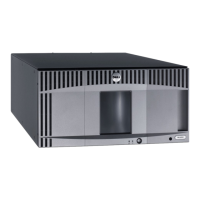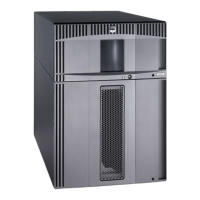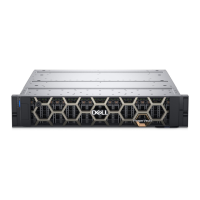Configuring Your Library
file:///T|/htdocs/stor-sys/ML6000/en/html/ch04.htm[9/17/2012 1:49:29 PM]
and user accounts. Users without administrator privileges cannot create accounts. The library can contain eighteen user
accounts, including the default administrator account.
To create local user accounts, you need to provide information for the following fields:
• User Name — the login name of the user account you are creating. User names are limited to 1–12 lower-case
letters, numbers, and underscores (_). For example: john_usa.
• Password — the unique password for the user account you are creating. Passwords are limited to 6–12 lower-case
alphanumeric characters and can include also include underscores (_), periods (.), hyphens (-), asterisks (*), and
ampersands (@). For example: pass_19.
• Privilege — is set to either User or Admin. See User Privileges for more information on user privilege levels.
The paths to open the appropriate screens are as follows:
• From the web client, select Setup > User Management > User Accounts.
• From the operator panel, select Setup > User Mgmt> Create User.
Modifying Local User Accounts
After a local user account has been created, administrators can modify the account settings, such as the password, privilege
level, and partition access. You cannot modify the user name. Instead, you will need to delete the user account and create a
new one.
To modify local user accounts, you need to provide information for the following fields:
• Password — the unique password for the user account you are creating. Passwords are limited to 6–12 lower-case
alphanumeric characters and can include also include underscores (_), periods (.), hyphens (-), asterisks (*), and
ampersands (@). For example: pass_19.
• Privilege — set to either User or Admin. See
User Privileges for more information on user privilege levels.
• Partition Access — the partitions to which this user has access. Any user assigned to a partition that has been
deleted can be reassigned to other partitions.
The paths to open the appropriate screens are as follows:
• From the Web client, select Setup > User Management > User Accounts.
• From the operator panel, select Setup > User Mgmt > Modify User.
Deleting Local User Accounts
Administrators can delete other local administrator and user accounts when they are no longer needed.
Note: The default administrator account cannot be deleted.
The paths to open the appropriate screens are as follows:
• From the Web client, select Setup > User Management > User Accounts.
• From the operator panel, select Setup > User Mgmt > Modify User.
Configuring LDAP
Administrators can enable and configure Lightweight Directory Access Protocol (LDAP). LDAP is the industry standard internet
protocol that provides centralized user account management.
Administrators can add, delete, and modify only local user account information. The library Web client does not allow you to
create, modify, or delete user account information on an LDAP server. This must be done by the directory service provider.
For more information on working with local user accounts, see
About Local User Accounts.
The library supports all LDAP servers. You can also use Kerberos for added security. For specific instructions on configuring
Kerberos, see
Configuring Kerberos.
The Login screen displays remote authentication login options only when LDAP is enabled.

